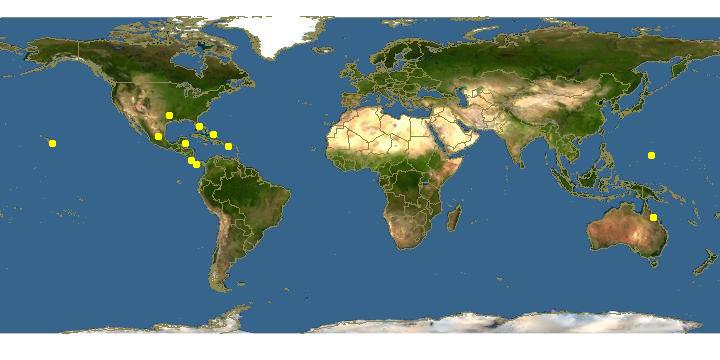
Click on map for details about points.
|
|
Overview | |
Cultivated on dilute hay infusion or 0.5% glucose, 0.1 % peptone agar in association with a mixed flora consisting of Klebsiella pneumoniae and Dematium nigrum at 25-30 C. Sorocarps arise from migrating pseudoplasmodia, very small, often solitary, but typically clustered to form coremiform fructifications, variable in number, rarely up to nine or ten per cluster, commonly 350-650 Ám in height. Sorophores erect, tapered, appressed throughout most of their length, diverging terminally to bear whitish or hyaline globose sori 40-90 Ám in diam. Spores elliptical to reniform, usually 6.0-7.5 x 3.0-3.5 Ám granules often evident but not consistently polar. Cell aggregations typically radial in pattern, often 5-10 mm in diam., producing few to many long, thin, and fragile migrating pseudoplasmodia up to 1.0 cm in length, not phototropic. Myxamoebae comparatively small, usually 8-12 x 5.0-7.5 Ám, sometimes larger or smaller. Unaggregated cells form microcysts, globose or nearly so, 4.0-6.5 Ám in diam.; macrocysts reported but not observed.
|
|
|
Links to other sites | |
|
|
|
Acknowledgements | |
The Eumycetozoan Project -- working to understand the ecology, sytematics and evolution of myxomycetes, dictostelids and protostelids -- the true slime molds.
Sponsored by grants from the National Science Foundation.
|
|
|
Feedback |
Please send any corrections and comments about this page to John Shadwick
Department of Biological Sciences, University of Arkansas, Fayetteville, AR 72701, USA
email: jshadwi@uark.edu
phone: USA-479-575-7393.
|
|
| Supported by | |
Updated: 2024-05-05 19:41:03 gmt
|